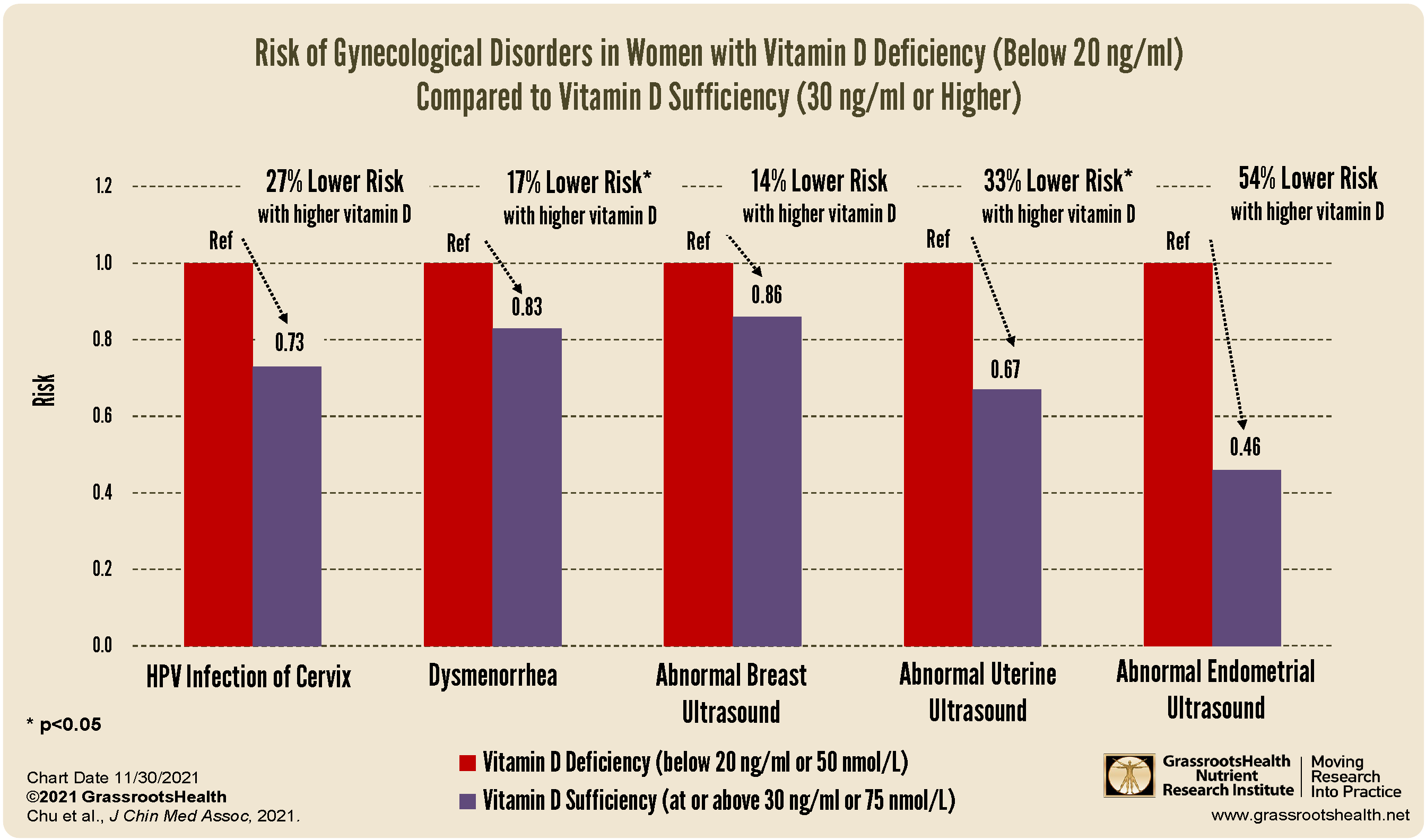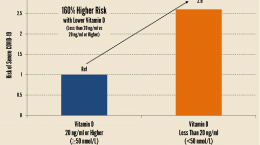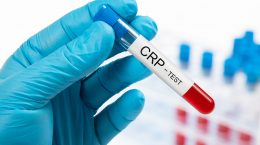Published on November 30, 2021
Study shows increased risk of abnormal Pap smear, HPV infection, painful periods, and abnormal ultrasounds of the breast, uterus, and endometrium among women with lower vitamin D levels
Key Points
- Vitamin D is necessary for many aspects of women’s health and reproductive health
- Previous research has shown that women who test positive for HPV infection of the cervix, or who receive abnormal Pap smear results, are more likely to have lower vitamin D levels; higher vitamin D levels have also been linked to a reduced risk for endometriosis, uterine myomas, and dysmenorrhea (pelvic pain with menstruation)
- A new study comparing women with vitamin D levels of at least 30 ng/ml (75 nmol/L) to women with levels below 20 ng/ml (50 nmol/L) found that women with higher levels had a 27% decreased risk of HPV infection of the cervix, 17% decreased risk of dysmenorrhea, and a decreased risk of abnormal ultrasounds of the breast (14%), uterus (33%), and endometrium (54%)
 Vitamin D is essential to women’s reproductive health; getting enough vitamin D can influence the regulation of certain hormonal pathways, follicular development and the menstrual cycle, fertility and conception time, and many aspects of prenatal health and fetal development.
Vitamin D is essential to women’s reproductive health; getting enough vitamin D can influence the regulation of certain hormonal pathways, follicular development and the menstrual cycle, fertility and conception time, and many aspects of prenatal health and fetal development.
Previous research has demonstrated a link between vitamin D levels and several gynecological disorders. For example, studies have shown that women who test positive for HPV infection of the cervix, or who receive abnormal Pap smear results, are more likely to have lower vitamin D levels than women who do not have these conditions. Other research has linked higher vitamin D levels to a reduced risk for endometriosis, uterine myomas, and dysmenorrhea (pelvic pain with menstruation).
New Study Confirms the Relationship Between Vitamin D Level and GYN Disorders
A study by Chu et al. looked at data from 7699 female adults (ages 20 years or older) to further investigate the association between a woman’s vitamin D level and the incidence of several specific gynecologic-associated diseases.
Only 16% of the women in the study had a vitamin D level of at least 30 ng/ml (75 nmol/L). 42% of the women had vitamin D deficiency, with levels below 20 ng/ml (50 nmol/L), and another 42% were labeled as insufficient, with levels between 20-30 ng/ml (50-75 nmol/L).
Compared to women with vitamin D levels below 20 ng/ml, the women with vitamin D levels of 30 ng/ml or higher had a
- 27% decreased risk of HPV infection of the cervix
- 17% decreased risk of dysmenorrhea
- decreased risk of abnormal ultrasounds of the breast (by 14%), uterus (by 33%), and endometrium (by 54%)
Not all findings were of significant value; additional associations were also found between vitamin D deficiency and endometriosis, uterine myoma, and abnormal Pap smear results.
Vitamin D is an Easily Modifiable Factor to Help Improve Disease Outcomes – Check Your Level Today
 Having and maintaining healthy vitamin D levels and other nutrient levels can help improve your health now and for your future. Choose which to measure, such as your vitamin D, omega-3s, and essential minerals including magnesium and zinc, by creating your custom home test kit today. Take steps to improve the status of each of these measurements to benefit your overall health. You can also track your own intakes, symptoms and results to see what works best for YOU.
Having and maintaining healthy vitamin D levels and other nutrient levels can help improve your health now and for your future. Choose which to measure, such as your vitamin D, omega-3s, and essential minerals including magnesium and zinc, by creating your custom home test kit today. Take steps to improve the status of each of these measurements to benefit your overall health. You can also track your own intakes, symptoms and results to see what works best for YOU.
Enroll and test your levels today, learn what steps to take to improve your status of vitamin D (see below) and other nutrients and blood markers, and take action! By enrolling in the GrassrootsHealth projects, you are not only contributing valuable information to everyone, you are also gaining knowledge about how you could improve your own health through measuring and tracking your nutrient status, and educating yourself on how to improve it.


 Click to Enlarge & Print
Click to Enlarge & Print


